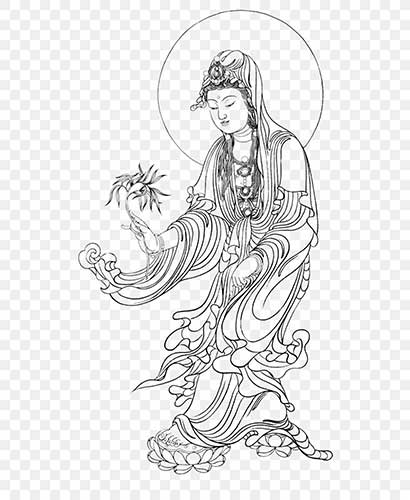The Lankavatara Sutra – Self-Realisation of Noble Wisdom
![]()
Chapter IX
The Fruit of Self-Realisation
Mahamati asked the Blessed One: Prey tell us, Blessed One, what is the fruitage that comes with the self-realisation of Noble Wisdom?
The Blessed One replied: First, there will come a clearing insight into the meaning and significance of things and following that will come an unfolding insight into the significance of spiritual ideals (Paramitas) by reason of whichthe Bodhisattva will be able to enter more deeply into the abode of imagelessness and be able to experience the higher Samadhis and gradually to pass through the higher stages of Bodhisattvahood.
After experiencing the “turning-about” in the deepest seat of consciousness, they will experience other Samadhis even to the highest, the Vajravimbopama, which belongs to the Tathagatas and their transformations. They will be able to enter into the realm of consciousness that lies beyond the consciousness of the mind-system, even the consciousness of Tathagatahood. They will become endowed with all the powers, psychic faculties, self-mastery, loving compassion, skillful means, and ability to enter into other Buddha-lands. Before they had attained self-realisation of Noble Wisdom they had been influenced by the self-interests of egoism, but after they attain self-realisation they will find themselves reacting spontaneously to the impulses of a great and compassionate heart endowed with skillful and boundless means and sincerly and wholly devoted to the emancipation of all beings.
* * *
Mahamati said: Blessed One, tell us about the sustaining power of the Tathagatas by which the Bodhisattvas are aided to attain self-realisation of Noble Wisdom?
The Blessed One replied: There are two kinds of sustaining power, which issue from the Tathagatas and are at the service of the Bodhisattvas, sustained by which the Bodhisattvas should prostrate themselves before them and show their appreciation by asking questions. The first kind of sustaining power is the Bodhisattva’s own adoration and faith in the Buddhas by reason of which the Buddhas are able to manifest themselves and render their aid and to ordain them with their own hands. The second kind of sustaining power is the power radiating from the Tathagatas that enables the Bodhisattvas to attain and to pass through the various Samadhis and Samapattis without becoming intoxicated by their bliss.
Being sustained by the power of the Buddhas, the Bodhisattva even at the first stage will be able to attain the Samadhi known as the Light of Mahayana. In that Samadhi Bodhisattvas will become conscious of the presence of the Tathagatas comming from all their different abodes in the ten quarters to impart to the Bodhisattvas their sustaining power in various ways. As the Bodhisattva Vajragarbha was sustained in his Samadhis and as many other Bodhisattvas of like degree and virtue have been sustained, so all earnest disciples and masters and Bodhisattvas may experience this sustaining power of the Buddhas in their Samadhis and Samapattis. The disciple’s faith and the Tathagata’s merit are two aspects of the same sustaining power and by it alone are the Bodhisattvas enabled to become one with the company of the Buddhas.
Whatever Samadhis, psychic faculties and teachings are realised by the Bodhisattvas, they are made possible only by the sustaining power of the Buddhas; if it were otherwise, the ignorant and the simple-minded might attain the same fruitage. Wherever the Tathagatas enter with their sustaining power there will be music, not only music made by human lips and played by human hands on various instruments, but there will be music among the grass and shrubs and trees, and in the mountains and towns and palaces and hovels; much more will there be music in the heart of those endowed with sentiency. The deaf, dumb and blind will be cured of their deficiencies and will rejoice in their emancipation. Such is the extraordinary virtue of the sustaining power imparted by the Tathagatas.
By the bestowal of this sutaining power, the Bodhisattvas are enabled to avoid the evils of passion, hatred and enslaving karma; they are enabled to transcend the dhyana of the beginners and to advance beyond the experience and truth already attained; they are enabled to demostrate the Paramitas; and finally, to attain the stage of Tathagatahood. Mahamati, if it were not for this sustaining power, they would relapse into the ways and thoughts of the philosophers, easy-going disciples and the evil-minded, and would thus fall short of the highest attainement. For these reasons, earnest disciples and sincere Bodhisattvas are sustained by the power of all the Tathagatas.
* * *
Then said Mahamati: It has been said by the Blessed One that by fulfilling the six Paramitasm Buddhahood is realised.
Pray tell us what the Paramitas are, and how they are to be fulfilled?
The Blessed One replied: The Paramitas are ideals of spiritual perfection that are to be the guide of the Bodhisattvas on the path to self-realisation. There are six of them but they are to be considered in three different ways according to the progress of the Bodhisattva on the stages. At first they are to be considered as ideals for the worldly life; next as ideals for the mental life; and, lastly, as ideals of the spiritual and unitive life.
In the worldly life where one is still holding tenaciously to the notions of an ego-soul and what concerns it and holding fast to the discriminations of dualism, if only for worldly benefits, one should cherish ideals of charity, good behavior, patience, zeal, thoughtfulness and wisdom. Even in the worldly life the practice of these virtues will bring rewards of happiness and success.
Much more in the mind-world of earnest disciples and masters will their practice bring joys of emancipation, enlightement and peace of mind, because the Paramitas are grounded on right-knowledge and lead to thoughts of Nirvana, even if the Nirvana of their thoughts is for themselves. In the mind-world the Paramitas become more ideal and more sympathetic; charity can no longer be expressed in the giving of impersonal gifts but will call for the more costly gifts of sympathy and understanding; good behavior will call for something more than outward conformity to the five precepts because in the light of the Paramitas they must practise humilty, simplicity, restraint and self-giving. Patience will call for something more than forbearance with external circunstances and the temperaments of other people: it will now call for patience with one’s self. Zeal will call for something more than industry and outward show of earnestness: it will call for more self-control in the task of following the Noble Path and in manifesting the Dharma in one’s own life. Thoughtfulness will give way to mindfulness wherein discriminated meanings and logical deductions and rationalisations will give way to intuitions of significance and spirit. The Paramita of Wisdom (Prajna) will no longer be concerned with pragmatic wisdom and erudition, but will reveal itself in its true perfectness of All-inclusive Truth which is Love.
The third aspect of the Paramitas as seen in the ideal perfection of the Tathagatas can only be fully understood by the Bodhisattva-Mahasattvas who are devoted to the highest spiritual disciple and have fully understood that there is nothing to be seen in the world but that which issues from the mind itself; in whose minds the discrimination of dualities has ceased to fuction; and seizing and clinging has become non-existent. Thus free from all attachements to individual objects and ideas, their minds are free to consider ways of benefiting and giving happiness to others, even to all sentient beings. To the Bodhisattva-Mahasattvas the ideal of charity is shown in the self-yielding of the Tathagata’s hope of Nirvana that all may enjoy it together. While having relations with an objective world there is no rising in the minds of the Tathagatas of discriminations between the interests of self and the interests of others, between good and evil,- there is just the
spontaneity and effortless actuality of perfect behavior. To practise patience with full knowledge of this and that, of grasp and grasping, but with no thought of discrimination nor of attachment,- that is the Tathagatas Paramita of Patience. To exert oneself with energy from the first part of the night to its end in conformity with the disciplinary measures with no rising of discrimination as to comfort or discomfort,- that is the Tathagata’s Paramita of Zeal. Not to discriminate between self and others in thoughts of Nirvana, but to keep the mind fixed on Nirvana,- that is the Paramita of Mindfulness. As to the Prajna-Paramita, which is Noble Wisdom, who can predicate it? When in Samadhi the mind ceases to discriminate and there is only perfect and love-filled imagelessness, then an inscrutable “turning-about” will take place in the inmost consciousness and one will have attained self-realisation of Noble Wisdom,- that is the highest Prajna-Paramita.
* * *
Then Mahamati said to the Blessed One: You have spoken of an astral-body, a “mind-vision-body” (manomayakaya) which the Bodhisattvas are able to assume, as being one of the fruits of self-realisation of Noble Wisdom: pray tell us, Blessed One, what is meant by such transcendental body?
The Blessed One replied: There are three kinds of such transcendental bodies: First, there is one in which the Bodhisattva attains enjoyment of the Samadhis and Samapattis. Second, there is the one which is assumed by the Tathagatas according to the class of beings to be sustained, and which achieves and perfects spontaneously with no attachment and no effort. Third, there is the one in which the Tathagatas receive their intuition of Dharmakaya.
The transcendental personality that enters into the enjoyment of the Samadhis comes with the third, fourth and fifth stages as the mentations of the mind-system become quieted and waves of consciouness are no more stirred on the face of Universal Mind. In this state, the conscious-mind is still aware, in a measure, of the bliss being experienced by this cessation of the mind’s activities.
The second kind of transcendental personality is the kind assumed by Bodhisattvas and Tathagatas as bodies of transformation by which they demostrate their original vows in the work of achieving and perfecting; it comes with the eighth stage of Bodhisattvahood. When the Bodhisattva has a thorough-going penetration into the maya-like nature of things and understands the dharma of imagelessness, he will experience the “turning-about” in his deepest consciousness and will become able to experience the higher Samadhis even to the highest. By entering into these exalted Samadhis he attains a personality that transcends the conscious-mind, by reason of which he obtains supernatural powers of self-mastery and activities because of which he is able to move as he wishes, as quickly as a dream changes as quickly as
an image changes in a mirror. This transcendental body is not a product of the elements and yet there is something in it that is analogous to what is so produced; it is furnished with all the differences appertaining to the world of form but without their limitations; possessed of this “mind-vision-body” he is able to be present in all the assemblages in all the Buddha-lands. Just as his thoughts move instantly and without hindrance over walls and rivers and trees and mountains, and just as in memory he recalls and visits the scenes of his past experiences, so, while his mind keeps fuctioning in the body, his thoughts may be a hundred thousand yojanas away. In the same fashion the trasncendental personality that experiences the Samadhi Vajravimbopama will be endowed with supernatural powers and psychic faculties and self-mastery by reason of which he will be able to follow the noble paths that lead to the assemblages of the Buddhas, moving about as freely as he may wish. But his wishes will no longer be self-centered nor tainted by discrimination and attachment, for this transcendental personality is not his old body, but is the transcendental embodiment of his original vows of self-yielding in order to bring all beings to maturity.
The third kind of transcendental personality is so ineffable that it is able to attain intuitions of the Dharmakaya, that is, it attains intuitions of the boundless and inscrutable cognition of Universal Mind. As Bodhisattva-Mahasattvas attain the highest of the stages and become conversant with all the treasures to be realised in Noble Wisdom, they will attain this inconceivable transformation-body which is the true nature of all the Tathagatas past, present and future, and will participate in the blissful peace which pervades the Dharma of all the Buddhas.
Chapter X
Discipleship: Lineage of the Arhats
Then Mahamati asked the Blessed One: Prey tell us how many kinds of disciples there are?
The Blessed One replied: There are as many kinds of disciples as there are individuals, but for convenience they may be divided into two groups: disciples of the lineage of the Arhats, and disciples known as Bodhisattvas. Disciples of the lineage of the Arhats may be considered under two aspects: First, according to the number of times they will return to this life of birth-and-death; and second, according to their spiritual progress. Under the first aspect, they may be subdivided into three groups: The “Stream-entered,” the “Once-returning,” and the “Never-returning.”
The Stream-entered are those disciples, who having freed themselves from the attachments to the lower discriminations and who have cleansed themselves from the twofold hindrances and who clearly understand the meaning of the twofold egolessness, yet who still cling to the notion of individuality and generality and to their own egoness. They will advance along the stages to the sixth only to succumb to the entrancing bliss of the Samadhis. They will be reborn seven times, or five times, or three times, before they will be able to pass the sixth stage. The Once-returning are the Arhats, and the Never-returning are the Bodhisattvas who have reached the seventh stage.
The reasons for these graduations is because of their attachment to the three degrees of false-imagination: namely, faith in moral practices, doubt, and the view of their individual personality. When this three hindrances are overcome, they will be able to attain the higher stages. As to moral practices: the ignorant, simple-minded disciples obey the rules of morality, piety and penance, because they desire thereby to gain worldly advancement and happiness, with the added hope of being reborn in more favorable conditions. The Stream-entered ones do not cling to moral practices for any hope of reward for their minds are fixed on the exalted state of self-realisation; the reason they devote themselves to the details of morality is that they wish to master such truths as are in conformity with the undefiled out-flowings. As regards the hindrance of doubt in the Buddha’s teaching, that will continue so long as any of the notions of discrimination are cherished and will disappear when they disappear. Attachment to the view of individual personality will be gotten rid of as the disciple gains a more thorough understanding of the notions of being and non-being, self-nature and egolessness, thereby getting rid of the attachments to his own selfness that goes with those discriminations. By breaking up and clearing away these three
hindrances the Stream-entered one will be able to discard all greed, anger and folly.
As for the Once-returning Arhats; there was once in them the discrimination of form, signs, and appearances, but as they gradually learned by right-knowledge not to view individual objects under the aspect of quality and qualifying, and as they became acquainted with what marks the attainment of the practice of dhyana, they have reached the stage of enlightement where in one more rebirth they will be able to put an end to the clinging to their own self-interests. Free from this burden of error and its attachments, the passions will no more assert themselves and the hindrances will be cleared away forever.
Under the second aspect disciples may be grouped according to the spiritual progress they have attained, into four classes, namely, disciples (sravaka), masters (pratyekabuddha), Arhats, and Bodhisattvas.
The first class of disciples mean well but they find it difficult to understand unfamiliar ideas. Their minds are joyful when studying about and practising the things belonging to appearances that can be discriminated, but they become confused by the notion of an uninterrupted chain of causation, and they become fearful when they consider the aggregates that make up personality and its object world as being maya-like, empty and egoless. They were able to advance to the fifth or sixth stage where they are able to do away with the rising of passions, but not with the notions that give rise to passion and, therefore, they are unable to get rid of the clinging to an ego-soul and its accompanying attachments, habits and habit-energy. In this same class the disciples are the earnest disciples of other faiths, who clinging to the notions of such things as, the soul as an external entity, Supreme Atman, Personal God, seek a that is in harmony with them. There are others, more materialistic in their ideas, who think that all things exist in dependance upon causation and, therefore, that Nirvana must be in like dependence. But none of these, earnest though they be, have gained an insight into the truth of the twofold egolessness and are, therefore, of limited spiritual insights as regards deliverance and non-deliverance; for them there is no emancipation. They have great self-confidence but they can never gain a true knowledge of Nirvana until they have learned to disciple themselves in the patient acceptance of the twofold egolessness.
The second class of masters are those who have gained a high degree of intellectual understanding of the truths concerning the aggregates that make up personality and its external world but who are filled with fear when they face the significance and consequences of these truths, and the demands which their learning makes upon them, that is, not to become attached to the external world and its manifold forms making for comfort and power, and to keep away from the entanglements of its social relations. They are attracted by the possibilities that are attainable by so doing, namely, the possesion of miraculous powers such as dividing the personality and appearning in different places at the same time, or manifesting bodies of transformation. To gain these powers they even resort to the solitary life, but this class of master never gets beyond the seductions of their learning and egoism, and their discourses are always in conformity with that characteristic and limitation. Among them are many earnest disciples who show a degree of spiritual insight that is characterised by sincerity and undismayed willingness to meet all the demands that the stages make upon them. When they see that all that nakes up the objective world is only a manifestation of mind, that it is without self-nature, un-born and egoless, they accept it without fear, and when they see their own ego-soul is also empty, un-born and egoless, they are untroubled and undismayed, with earnest purpose they seek to adjust their lives to the full demands of these truths, but they cannot forget the notions that lie back of these facts, especially the notion of their own conscious ego-self and its relation to Nirvana. They are of the Stream-entered class.
The class known as Arhats are those earnest masters who belong to the returning class. But their spiritual insight they have reached the sixth and seventh stages. They have thoroughly understood the truth of the twofold egolessness and the imagelessness of Reality; with them there is no more discrimination, nor passions, nor pride of egoism; they have gained an exalted insight and seen into the immensity of the Buddha-lands. By attaining an inner perception of the true nature of Universal Mind they are steadily purifying their habit-energy. The Arhats has attained emancipation, enlightement, the Dhyanas, the Samadhis, and his whole attention is given to the attainment of Nirvana, but the idea of Nirvana causes mental perturbations because he has the wrong idea of Nirvana. The notions of Nirvana in his mind is divided: he discriminated Nirvana from self, and self from others. He has attained some of the fruits of self-realisation but he still thinks and discourses on the Dhyanas, subjects for meditation, the Samadhis, the fruits. He pridefully says: “There are fetters, but I am disengaged from them.” His is a double fault: he both denounces the vices of the ego, and still cling to its fetters. So long as he continues to discriminate notions of dhyana, dhyana practice, subjects fro dhyana, right-knowledge and truth, there is a bewildered state of mind,- he has not attained perfect emancipation. Emancipation comes with the acceptance of imagelessness.
He is master of the Dhyanas and enters into the Samadhis, but to reach the higher stages one must pass beyond the Dhyanas, the immeasurables, the world of no-form, and the bliss of the Samadhis into the Samapattis leading to the cessation of thought itself. The dhyana-practicer, dhyana, the subject of dhyana, the cessation of thought, once-returning, never-returning, all these are divided and bewildering states of mind. Not until all discrimination is abandoned is there perfect emancipation. Thus the Arhats, master of the dhyanas, participating in the Samadhis, but unsupported by the Buddhas yields to the entrancing bliss of the Samadhis – and passes to his Nirvana.
Disciples and masters and Arhats may ascend the stages up to the sixth. They perceive that the triple world is no more than mind itself; they perceive that there is no becoming attached to the multiciplicites of external objects except through the discriminations and activities of the mind itself; they perceive that there is no ego-soul; and, therefore, they attain a measure of tranquilisation. But their tranqulisation is not perfect every minute of their lives, for with them there is something effect-producing, some grasped and grasping, some lingering trace of dualism and egoism. Though disengaged from the habit-energy of passion and, becoming intoxicated with the wine of the Samadhis, they will have their abode in the realm of the out-flowings. Perfect tranqulisation is possible only with the seventh stage. So long as their minds are in confusion, they cannot attain to a clear conviction as to the cessation of all multiplicity and the actuality of the perfect oneness of all things. In their minds the self-nature of things is still discriminated as good and bad, therefore, their minds are in confusion and they cannot pass beyond the sixth stage. But at the sixth stage all discrimination ceases as they become engrossed in the bliss of the Samadhis wherein they cherish the thought of Nirvana and, as Nirvana is possible at the sixth stage, they pass into their Nirvana, but it is not the Nirvana of the Buddhas.

OPENING HOURS
| Week Days | 8:00 – 5:00 |
| Saturday | 9:00 – 5:00 |
| Sunday | 11:00 – 4:00 |




